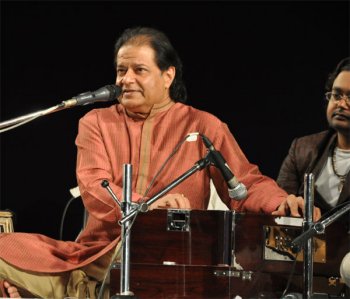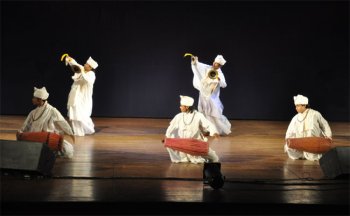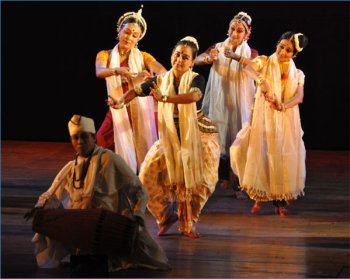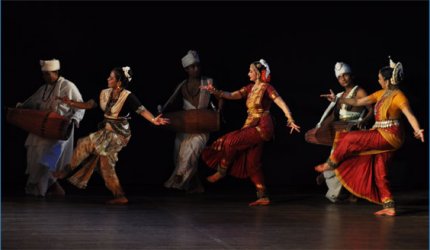
|   |

|   |
Sankardev Utsav: a tribute - Dr. Sunil Kothari e-mail: sunilkothari1933@gmail.com Pics courtesy: Pratishruti Foundation April 11, 2013 Under the aegis of Pratishruti Foundation, Sattriya dancer Prateesha organized Sankardev Utsav, inviting monks led by Adhyapaka Tankeswar Barabayan from original Kamalabari Sattra from Majuli Island, Assam, now shifted to Titabar, near Jorhat, after the floods in Brahmaputra River in mid seventies. Though Sattriya dances have been recognized as the eighth classical dance form of India in the year 2000, precious little is known about this dance form in major metropolitan cities, barring the Capital. Fortunately for Mumbaikars, in Prateesha Suresh (Saikia), they have a crusader, who is determined to popularize Sattriya dances by presentations, lec-dems, performances, seminars, collaborating with other leading dancers of Mumbai and bring Sattriya, the classical dance heritage of Assam, within the fold of performing arts in Mumbai. Prateesha decided to give few Bargeets, the songs written by the 15th century saint Sankardeva and his disciple Madhavadeva, to exponents like Jhelum Paranjape (Odissi), Mandakini Trivedi (Mohiniattam) and Anusree Bonnerjee (Bharatanatyam) and selecting one for herself to present it in Sattriya form. Individually, each dancer, using the medium in which she is well versed, choreographed the song in classical dance form, Jhelum in Odissi, Mandakini in Mohiniattam, Anusree in Bharatanatyam and Prateesha in Sattriya, using the traditional music which is used for accompanying the respective form. Only the two vocalists rendered the Bargeets in Brajabuli, a mixture of Assamese and Mythili, Avadhi, Braj languages with traditional Assamese music keeping its Assamese flavor. The programme was held at YB Chavan Auditorium in Mumbai on 30th March 2013. It was sponsored by Tata Capital, Hinduja, and Oil India Ltd.  Anup Jalota Sattriya dances on a concert platform begin with Gayan Bayan in which a group of monks, dressed in spotless white dhoti, angarakha and pugree, play complicated talas upon khol and as back up boys, the other monks play large cymbals, moving in various ways, creating choreographic patterns. From Manipur, a parallel form Pung cholom, performing on Pung, a mridang like instrument is well known in which male dancers play Pung and dance, often stunning audiences with breathtaking aerial movements, jumps, circling, while continuing playing upon the Pung. In Sattriya also, dancers play khol/mridang and execute various hand gestures, standing, sitting, playing upon khol with both palms on one side, striking the body of the khol, get up, circle, and the cymbal players keeping the taal, also play cymbals with typical sound, striking with force, sometimes also striking them on the floor, moving in opposite directions, facing each other and improvising, revealing the rich variety of typical Assamese taal patterns.  Gayan Bayan performed by
the bhaktas of Shri Titabor Kamalabari Sattra The musicians were seated on either side on the stage. The main khol player Srimanta Borah and two vocalists Sachikanta Rath and Keshab Baruah sat next to him, followed by flautist Kiran Hegde and violinist Siddharth Sarkar. KNP Nambisan played chenda and eddaka for Mohiniattam. For Odissi, pakhavaj was played by Rohan Dahale. For Bharatanatyam, mridangam by KN Venkiteswaran, nattuvangam by Nilesh Singha, the full compliment of the musicians looked very impressive. And they did a perfect job, giving flavor of each dance form with the regional music and maintaining the autonomy of musical tradition. An interesting interlude was before each song, the monks and the dancers entered on the stage, moving from one direction to another, creating visually exciting movements. Then a solo dancer would appear dancing to the Bargeet. From Sankardeva's well known ankiya nat, one act play, dance-drama Keli Gopal, the song selected for Odissi had motherly love as a central emotion. Krishna's stealing butter, playing pranks with gopis and their complaint to mother Yashoda, but in the end overcome by the love for child Krishna was enacted by Jhelum with her customary finesse and facial expressions, bringing to the fore the Odissi ethos, which coalesced in a seamless manner with Bargeet. Rohan Dahale's mardal/ pakhavaj accompaniment and rendering the ukutas, the mnemonic syllables, were perfect. Anusree Bonnerjee is a disciple of late Mahalingam Pillai of Raja Rajeswari Bharata Natya Kala Mandir, well known for Tanjore style. Beginning with slow movements using the straight lines of Bharatanatyam, establishing the formal structure, she moved on to rhythmic variations. With Nilesh Singh conducting nattuvangam and Venkiteswaran playing upon mridangam, Anusree depicted the mesmerizing effect of Krishna's flute upon human beings and on birds, animals, nature. Listening to his divine flute, they all are completely under the spell, leave their chores incomplete and get lost in the magical sound of the flute. Birds stop flying, deer stand still looking at Krishna, the bewitched gopis stare at him listening to the notes. While leaving the stage, Anusree took thrice - tihai, the Kaliya Mardana pose, very suggestive of the sports of Krishna, subjugating Kaliya serpent. She embellished the presentation with sparkling nritta. Mandakini Trivedi in Mohiniattam was in her element. Performing to the Bargeet in which Gopis take away all ornaments, clothes, flute of Krishna while playing and make him surrender unto them, Mandakini as gopi walked nonchalantly, demanding from Krishna ornaments, snatching his flute , running and dancing joyously. Using the Mohiniattam movements gracefully, she also resorted to lokadharmi, natural movements which were quite appealing and added charm to the playfulness of Krishna and gopis. Nambisan gave her adequate support playing upon maddalam. Prateesha displaying the typical Prakriti Pak, female stance, the kinetic movements of Sattriya performing to the Bargeet, enacted the story in which she explored the episodes of Rama's deeds and also Krishna's. Kubja, the hunched maid who adores Krishna, in her previous birth was Surpanakha, who was overwhelmed seeing the beauty of Lord Rama and Lakshmana but was punished for her advances. There was an episode of Sabari offering the cherries to Lord Rama after tasting them. As deformed Kubja, Prateesha brought Kubja's character alive. I did not know the mythological version of Kubja being Surpanakha in previous birth and was quite intrigued. However, the explanation helped in appreciating the rich imageries and impersonations. Prateesha is petite and performs with natural grace, keeping Sattriya movements clear. Though like her contemporaries she has also studied Bharatanatyam, she has consciously avoided Bharatanatyam influence and succeeded in keeping Sattriya dance movements as they should be with regional flavor. An interesting aspect was the use of the ragas traditionally employed by the monks in the sattras. This is an important aspect of familiarizing the audiences abut the musical heritage of Assam and bringing it within the reach of pan-Indian rasikas. The ragas (according to tradition) for the songs used were as follows: for the song 'Gowarini koisono kalanka hamari' - Belowar, 'Shyama muruti peeta ambaru lasa' - Naat, 'Braja ramani sange khelata gopala'- Maur and 'E hari kotiu koriu meri karuna murari'- Tur Bhatiali. The talas were for Gowarini - Khanda (originally Misra but changed for Odissi to Khanda), 'Shyama muruti' - Pori Taal, 'Braja ramani' - Kharman taal and 'E hari' - Sutkola taal. Except for Sattriya dance by Prateesha, the other songs followed their own percussion. The number of beats followed were 5,7, 3 and 7 respectively as per the original composition except for Odissi as Misra in Sattriya is a mix of 4 taals coming to 3 beats and not 7 which is generally understood when it is said 'misra' in Assam. 

The finale in which with the monks, all the four dancers perform in circle, like Rasalila, a gopi facing the drummer, moving in zig-zag way, crossing the floor, moving ahead of the drummer to the next drummer, coming in the centre centrifugal movements and then dispersing and in the end like in Sattra, the monks conclude moving in serpentine manner, or like insects flying over water running in mindboggling manner, in fast tempo. All the dancers danced in a flawless manner, winning rounds of applause from the audience, who gave them a standing ovation. Bravo Prateesha, Mandakini, Jhelum, Anusree and the monks from Kamalabari! Prateesha's daughter Janani who's learning music, was the compere for the evening and did a good job, explaining the relevance of Sankardeva's message and the import of Bargeets. Sattriya dances need support from various quarters. Since I have studied the form for many years, visiting sattras in Assam and interacting with monks, dancers, musicians, I feel it is time that established exponents of different dance forms also study Sattriya and perform it. This is a very good first step using Sankardeva's and Madhavadeva's songs in respective dance styles like Bharatanatyam, Odissi, Mohiniattam, but if these very three dancers, Jhelum, Anusree and Mandakini were to practice enough and perform even one number together in Sattriya style, I am sure it would enhance the formal beauty of Sattriya, four of them dancing together! Dancers like Sonal Mansingh, Yamini Krishnamurthy, Ritha Devi, Madhavi Mudgal and others took to Odissi, established dancers from other styles. If they shall take to Sattriya, Sattriya will have devotees from all parts of India and it would enrich our dance traditions.  Dr. Sunil Kothari is a dance historian, scholar, author and a renowned dance critic. He is Vice President of World Dance Alliance Asia Pacific India chapter, based in New Delhi. He is honored by the President of India with Padma Shri, Sangeet Natak Akademi award and Senior Critic Award from Dance Critics Association, NYC. He is a regular contributor to www.narthaki.com, the roving critic for monthly magazine Sruti and is a contributing editor of Nartanam for the past 12 years. Post your comments Pl provide your name and email id along with your comment. All appropriate comments posted with name and email id in the blog will also be featured in the site. |